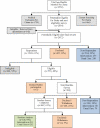Effectiveness of a patient- and practice-level colorectal cancer screening intervention in health plan members: design and baseline findings of the CHOICE trial
- PMID: 20143439
- PMCID: PMC2938956
- DOI: 10.1002/cncr.24962
Effectiveness of a patient- and practice-level colorectal cancer screening intervention in health plan members: design and baseline findings of the CHOICE trial
Abstract
Background: : Evidence-based interventions have been found effective in increasing colorectal cancer (CRC) screening. Translating these successful interventions into real world settings, such as health plans, can be challenging.
Methods: : CHOICE (Communicating Health Options through Information and Cancer Education) is a controlled trial to test the effectiveness of a patient- and practice-level intervention to increase use of recommended CRC screening tests. The patient-level intervention was a patient decision aid and stage-targeted brochures, mailed to eligible health plan members, to provide information about CRC, available screening tests, and how to obtain CRC screening at their physicians' practices. The practice-level intervention was academic detailing to prepare practices to facilitate CRC testing once the patient was activated by the decision aid. Surveys and claims data will be used to assess CRC screening test completion.
Results: : Thirty-two primary care practices in Florida and Georgia participated. The authors recruited 443 participating health plan members for the trial; 211 were patients in intervention practices, and 232 were in usual care practices. Study participants reflected an insured population; the majority were white and aged <60 years. The authors also mailed the intervention to 343 people from intervention practices who did not respond to the eligibility or baseline survey. Receipt of screening in that group will be compared with screening among 319 people from usual care practices who did not respond to these surveys using claims data.
Conclusions: : The CHOICE study will demonstrate the effect of 2 combined evidence-based interventions on CRC screening test completion among health plan members. Cancer 2010. (c) 2010 American Cancer Society.
Figures
References
-
- United States Cancer Statistics: 2004 Incidence and Mortality. US Department of Health and Human Services, CEDC, National Cancer Institute; Atlanta: 2007.
-
- ACS How Many People Get Colorectal Cancer? [05/07/2007]. Available from: http://www.cancer.org/docroot/CRI/content/CRI_2_2_1X_How_Many_People_Get....
-
- MMWR Use of colorectal cancer tests--United States, 2002, 2004, and 2006. MMWR Morb Mortal Wkly Rep. 2008 Mar 14;57(10):253–258. - PubMed
-
- Shapiro JA, Seeff LC, Thompson TD, Nadel MR, Klabunde CN, Vernon SW. Colorectal cancer test use from the 2005 National Health Interview Survey. Cancer Epidemiol Biomarkers Prev. 2008 July;17(7):1623–1630. 2008. - PubMed
-
- Pignone M, Harris R, Kinsinger L. Videotape-based decision aid for colon cancer screening. A randomized, controlled trial. Ann Intern Med. 2000 Nov 21;133(10):761–769. - PubMed
MeSH terms
Grants and funding
LinkOut - more resources
Full Text Sources
Medical


